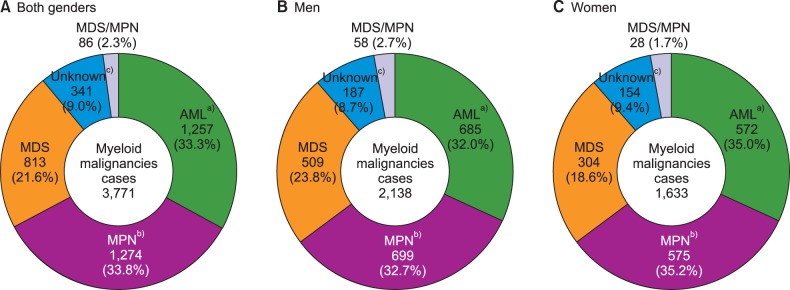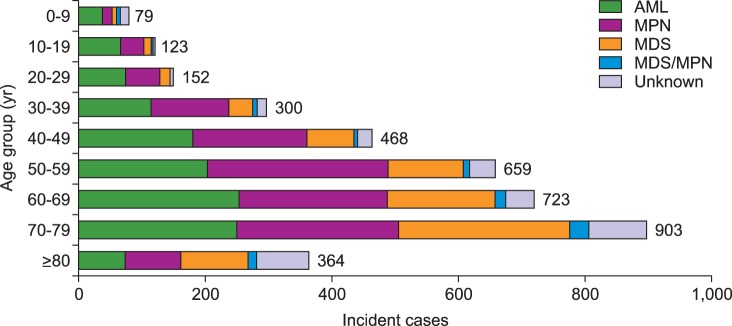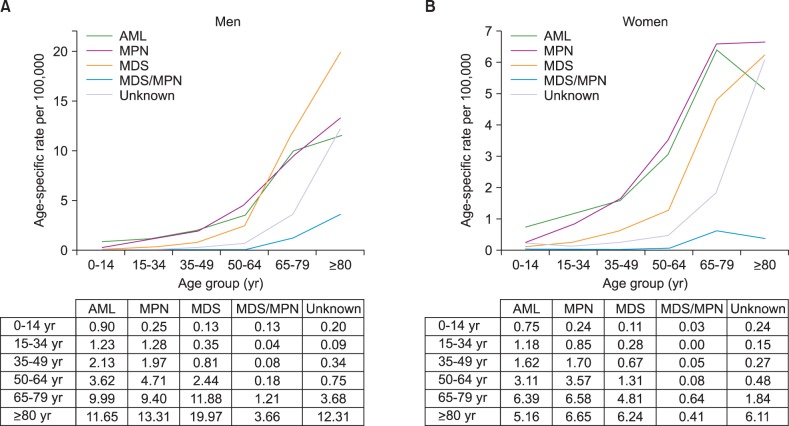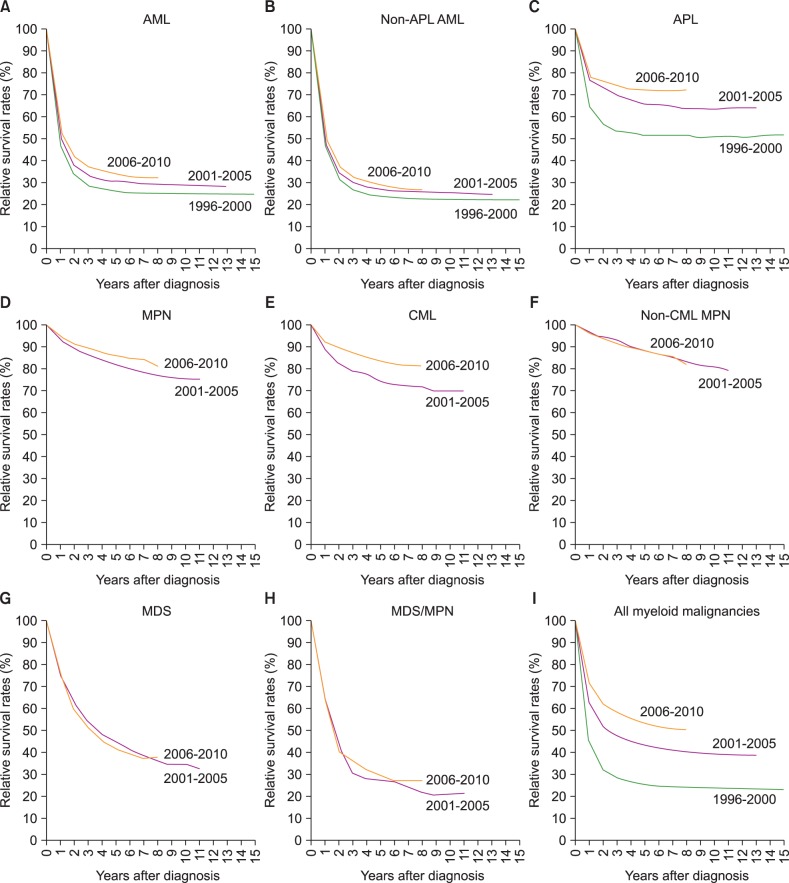Nationwide statistical analysis of myeloid malignancies in Korea: incidence and survival rate from 1999 to 2012
- Affiliations
-
- 1The Korea Central Cancer Registry, Division of Cancer Registration and Surveillance, National Cancer Center, Goyang, Korea.
- 2Hematologic Oncology Clinic, National Cancer Center, Goyang, Korea.
- 3Center for Pediatric Oncology, National Cancer Center, Goyang, Korea. hjpark@ncc.re.kr
- 4Department of Cancer Control and Policy, National Cancer Center, Goyang, Korea.
- 5Department of System Cancer Science, Graduate School of Cancer Science and Policy, National Cancer Center, Goyang, Korea.
- KMID: 2133755
- DOI: http://doi.org/10.5045/br.2015.50.4.204
Abstract
- BACKGROUND
Large-scale epidemiologic analysis for hematologic malignancies will be helpful to understand the trends in incidence and survival.
METHODS
The Korea Central Cancer Registry (KCCR) updated the nationwide analysis on the incidence and survival of myeloid malignancies, from the Korean National Cancer Incidence Database between 1999 and 2012. Myeloid malignancies were classified based on the International Classification of Diseases for Oncology 3rd edition (ICD-O-3).
RESULTS
Overall 3,771 cases of myeloid diseases, which was 1.7% of all cancers, were identified in 2012. The highest incidence of myeloid malignancies was observed in age 70s and male predominance was noted (1.3:1). Acute myeloid leukemia (AML) was the most frequent subtype, followed by myeloproliferative neoplasms (MPN), myelodysplastic syndrome (MDS) and MDS/MPN: age-standardized incidence rates (ASR) in 2012 for each disease were 2.02, 1.95, 1.13, and 0.12 per 100,000 persons, respectively. The ASR for all myeloid malignancies was increased from 3.31 in 1999 to 5.70 in 2012 with the annual percentage change (APC) of 5.4 %. Five-year relative survival rate (RS) for myeloid malignancies has gradually improved for decades. RS changed from 26.3% to 34.8% in AML, specifically from 51.6% to 69.6% in acute promyelocytic leukemia (APL) and from 23.8% to 29.9% in non-APL AML, between 1996-2000 and 2008-2012. RS also increased from 81.8% to 87.1% in MPN, with a significant improvement in CML (from 74.5% to 85.5%), and from 27.3% to 31.7% in MDS/MPN between 2001-2005 and 2008-2012. However, there was no survival improvement in MDS during the study period (45.6% in 2001-2005 to 44.4% in 2008-2012).
CONCLUSION
This report updated the nationwide statistical analysis on myeloid malignancies since 2008, showing increasing incidence and improving trends in survival.
Keyword
MeSH Terms
Figure
Cited by 5 articles
-
국내 혈액암 질환의 증가 양상: 2005년부터 2015년까지 국민건강보험 빅데이터에 근거하여
Yujin Han, Young Jin Kim, Min Jin Kim, Ja Min Byun, Taemi Youk, Hoi Soo Yoon, Jae Hee Lee, Woo-In Lee, Tae Sung Park, Jongha Yoo
Lab Med Online. 2020;10(2):144-151. doi: 10.3343/lmo.2020.10.2.144.Improvement of treatment outcome over 2 decades in children with acute myeloid leukemia
Tae Yang Song, Sang Hoon Lee, Gun Kim, Hee Jo Baek, Tai Ju Hwang, Hoon Kook
Blood Res. 2018;53(1):25-34. doi: 10.5045/br.2018.53.1.25.Twenty-year incidence trend of hematologic malignancies in the Republic of Korea: 1999‒2018
Won-Ju Park, Joo-Heon Park, Seunghyeon Cho, Myung Geun Shin
Blood Res. 2021;56(4):301-314. doi: 10.5045/br.2021.2021187.FLT3 mutations in acute myeloid leukemia: a review focusing on clinically applicable drugs
Jae-Sook Ahn, Hyeoung-Joon Kim
Blood Res. 2022;57(S1):32-36. doi: 10.5045/br.2022.2022017.Real-World Treatment Patterns and Clinical Outcomes in Korean Patients With AML Ineligible for First-Line Intensive Chemotherapy: A Subanalysis of the CURRENT Study, a Non-Interventional, Retrospective Chart Review
Soo-Mee Bang, Ka-Won Kang, Ik-Chan Song, Cynthia Llamas, Yinghui Duan, Ji-Young Jeong, Je-Hwan Lee
J Korean Med Sci. 2023;38(44):e345. doi: 10.3346/jkms.2023.38.e345.
Reference
-
1. Swerdlow SH, Campo E, Harris NL, editors. WHO classification of tumours of haematopoietic and lymphoid tissues. 4th ed. Lyon, France: IARC Press;2008.2. Vardiman JW, Thiele J, Arber DA, et al. The 2008 revision of the World Health Organization (WHO) classification of myeloid neoplasms and acute leukemia: rationale and important changes. Blood. 2009; 114:937–951. PMID: 19357394.
Article3. Percy CL, Fritz AG, Jack A, editors. International classification of diseases for oncology (ICD-O). 3rd ed. Geneva, Switzerland: World Health Organization;2013.4. Marcos-Gragera R, Allemani C, Tereanu C, et al. Survival of European patients diagnosed with lymphoid neoplasms in 2000-2002: results of the HAEMACARE project. Haematologica. 2011; 96:720–728. PMID: 21330324.
Article5. Sant M, Allemani C, Tereanu C, et al. Incidence of hematologic malignancies in Europe by morphologic subtype: results of the HAEMACARE project. Blood. 2010; 116:3724–3734. PMID: 20664057.
Article6. National Cancer Institute. Surveillance, Epidemiology, and End Results (SEER) Program Research Data (1973-2012). Bethesda, MD: National Cancer Institute;2015. Accessed October 2, 2015. http://seer.cancer.gov/data/.7. Shin HR, Won YJ, Jung KW, et al. Nationwide cancer incidence in Korea, 1999~2001; First result using the national cancer incidence database. Cancer Res Treat. 2005; 37:325–331. PMID: 19956367.
Article8. Park HJ, Park EH, Jung KW, et al. Statistics of hematologic malignancies in Korea: incidence, prevalence and survival rates from 1999 to 2008. Korean J Hematol. 2012; 47:28–38. PMID: 22479275.
Article9. Korea Central Cancer Registry, National Cancer Center. Annual report of cancer statistics in Korea in 2012. Seoul, Korea: Ministry of Health and Welfare;2014.10. Howlader N, Noone AM, Krapcho M, et al. SEER cancer statistics review, 1975-2010. Bethesda, MD: National Cancer Institute;2015. Accessed October 2, 2015. http://seer.cancer.gov/csr/1975_2010/.11. Ederer F, Axtell LM, Cutler SJ. The relative survival rate: a statistical methodology. Natl Cancer Inst Monogr. 1961; 6:101–121. PMID: 13889176.12. Ederer F, Heise H. Instructions to IBM 650 programmers in processing survival computations, technical, end results evaluation section. Bethesda, MD: National Cancer Institute;1959.13. Dickman PW, Sloggett A, Hills M, Hakulinen T. Regression models for relative survival. Stat Med. 2004; 23:51–64. PMID: 14695639.
Article14. World Health Organization. International statistical classification of diseases and related health problems (ICD-10) in occupational health. Geneva, Switzerland: World Health Organization;1999.15. Eden T. Aetiology of childhood leukaemia. Cancer Treat Rev. 2010; 36:286–297. PMID: 20223594.
Article16. Alexander FE. The search for causes of the leukaemias. Eur J Cancer. 1995; 31A:863–867. PMID: 7646912.
Article17. Gorini G, Stagnaro E, Fontana V, et al. Alcohol consumption and risk of leukemia: A multicenter case-control study. Leuk Res. 2007; 31:379–386. PMID: 16919329.
Article18. Maynadié M, De Angelis R, Marcos-Gragera R, et al. Survival of European patients diagnosed with myeloid malignancies: a HAEMACARE study. Haematologica. 2013; 98:230–238. PMID: 22983589.
Article19. Jung KW, Won YJ, Kong HJ, Oh CM, Lee DH, Lee JS. Cancer statistics in Korea: incidence, mortality, survival, and prevalence in 2011. Cancer Res Treat. 2014; 46:109–123. PMID: 24851102.
Article20. Larson RA. Therapy-related myeloid neoplasms. Haematologica. 2009; 94:454–459. PMID: 19336749.
Article21. Sant M, Minicozzi P, Mounier M, et al. Survival for haematological malignancies in Europe between 1997 and 2008 by region and age: results of EUROCARE-5, a population-based study. Lancet Oncol. 2014; 15:931–942. PMID: 25030467.
Article22. Gooley TA, Chien JW, Pergam SA, et al. Reduced mortality after allogeneic hematopoietic-cell transplantation. N Engl J Med. 2010; 363:2091–2101. PMID: 21105791.
Article23. Higby DJ, Cohen E, Holland JF, Sinks L. The prophylactic treatment of thrombocytopenic leukemic patients with platelets: a double blind study. Transfusion. 1974; 14:440–446. PMID: 4607226.
Article24. Walsh TJ, Finberg RW, Arndt C, et al. National Institute of Allergy and Infectious Diseases Mycoses Study Group. Liposomal amphotericin B for empirical therapy in patients with persistent fever and neutropenia. National Institute of Allergy and Infectious Diseases Mycoses Study Group. N Engl J Med. 1999; 340:764–771. PMID: 10072411.25. Appelbaum FR, Gundacker H, Head DR, et al. Age and acute myeloid leukemia. Blood. 2006; 107:3481–3485. PMID: 16455952.
Article26. Kantarjian H, O'brien S, Cortes J, et al. Results of intensive chemotherapy in 998 patients age 65 years or older with acute myeloid leukemia or high-risk myelodysplastic syndrome: predictive prognostic models for outcome. Cancer. 2006; 106:1090–1098. PMID: 16435386.
- Full Text Links
- Actions
-
Cited
- CITED
-
- Close
- Share
- Similar articles
-
- Statistics of hematologic malignancies in Korea: incidence, prevalence and survival rates from 1999 to 2008
- Nationwide Statistical Analysis of Lymphoid Malignancies in Korea
- Twenty-year incidence trend of hematologic malignancies in the Republic of Korea: 1999‒2018
- Cancer Statistics in Korea: Incidence, Mortality, Survival, and Prevalence in 2014
- Cancer Statistics in Korea: Incidence, Mortality, Survival, and Prevalence in 2015





